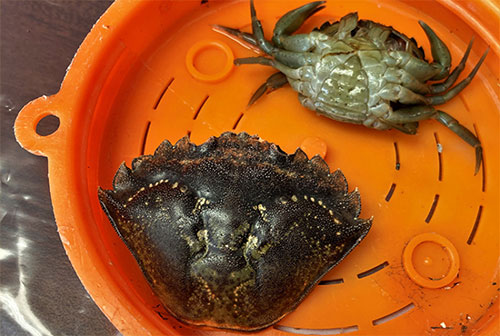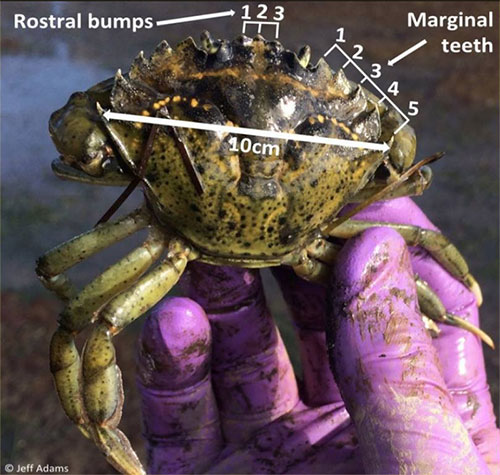The carapace of an invasive green crab, and a live green crab. |
The green crab has been found in U.S. waters since the 1800s, but this is the first confirmed presence in Alaska. They are a threat to native species and habitats. They are highly competitive predators that can decimate shellfish populations, outcompete native crabs, and reduce eelgrass and salt marsh habitats. They are a serious threat for Alaska’s tidal habitats.
In 2020, the Metlakatla Indian Community began an early detection program. This made data collection more efficient and increased the monitoring areas. No green crabs were found in 2020 or 2021. During a molt survey in July 2022, the team found three shed carapaces from invasive green crabs. This set off a multistakeholder response to address their presence.
A team of Community and NOAA staff worked with a Sealaska Heritage Institute Intern, Natalie Bennett. They took a multi-pronged approach with carapace surveys and trapping to make this discovery.
“Natalie found the first carapace rather high in the intertidal zone. Later, crabs were found in tide pools and deeper areas. This experience gave us valuable insight in looking for founder populations of green crab in southern Southeast Alaska,” said Linda Shaw, a wildlife biologist with NOAA Fisheries in Alaska.
Future surveys will allow scientists to monitor the presence and expansion of the green crab. The Alaska Department of Fish and Game will be expanding trapping efforts in the region to monitor more areas. By immediately being made aware of their presence, monitoring will allow for future adaptations to control the species’ population in Alaska.
The Metlakatla Indian Community, NOAA Fisheries, and Alaska Department of Fish and Game have built a strong partnership. They provide technical and financial support, technical assistance, and subject matter experts to bolster the community-based monitoring program.
Identifying an invasive green crab. |
Report Green Grab Sightings
“One point that will be important to cover for anyone searching for invasive European green crabs in or near Alaska waters is that regulations prohibit collection, possession, and transport of banned invasive species. European green crabs are listed as a banned invasive species,” said Tammy Davis with Alaska Department of Fish and Game.
Invasive green crabs have distinct physical features that distinguish them from other crabs. Their shell is a green-brown color with three rounded bumps between the eyes and five marginal teeth on each side of the eye.
If you see an invasive green crab on Annette Islands Reserve, call (907) 886-FISH to make a report.
If you encounter a potential green crab elsewhere in Alaska, take photographs from multiple angles and send them to Tammy Davis. Then submit a report to the Alaska Invasive Species Reporter, or call the Invasive Species Hotline: (877) INVASIV.
Related:
Metlakatla Indain Community & Dept of Fish and Wildlife deploys updated methods to monitor invasive species
SitNews - March 07, 2022
Edited By: Mary Kauffman, SitNews
Source of News:
NOAA Fisheries
www.fisheries.noaa.gov
Representations of fact and opinions in comments posted are solely those of the individual posters and do not represent the opinions of Sitnews.
Send a letter to the editor@sitnews.us
SitNews ©2022
Stories In The News
Ketchikan, Alaska
Articles & photographs that appear in SitNews are considered protected by copyright and may not be reprinted without written permission from and payment of any required fees to the proper freelance writers and subscription services.
E-mail your news & photos to editor@sitnews.us
Photographers choosing to submit photographs for publication to SitNews are in doing so granting their permission for publication and for archiving. SitNews does not sell photographs. All requests for purchasing a photograph will be emailed to the photographer.


